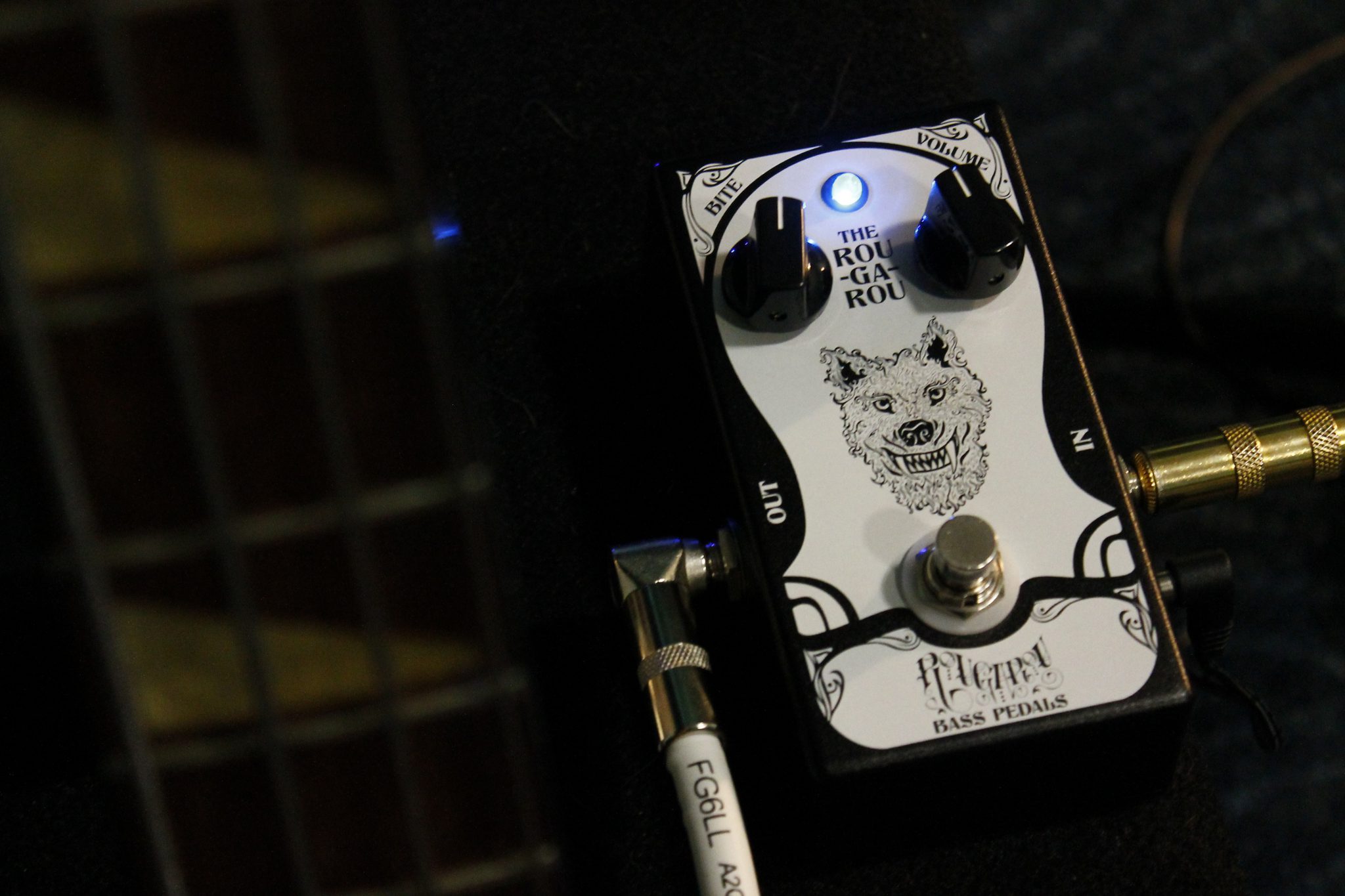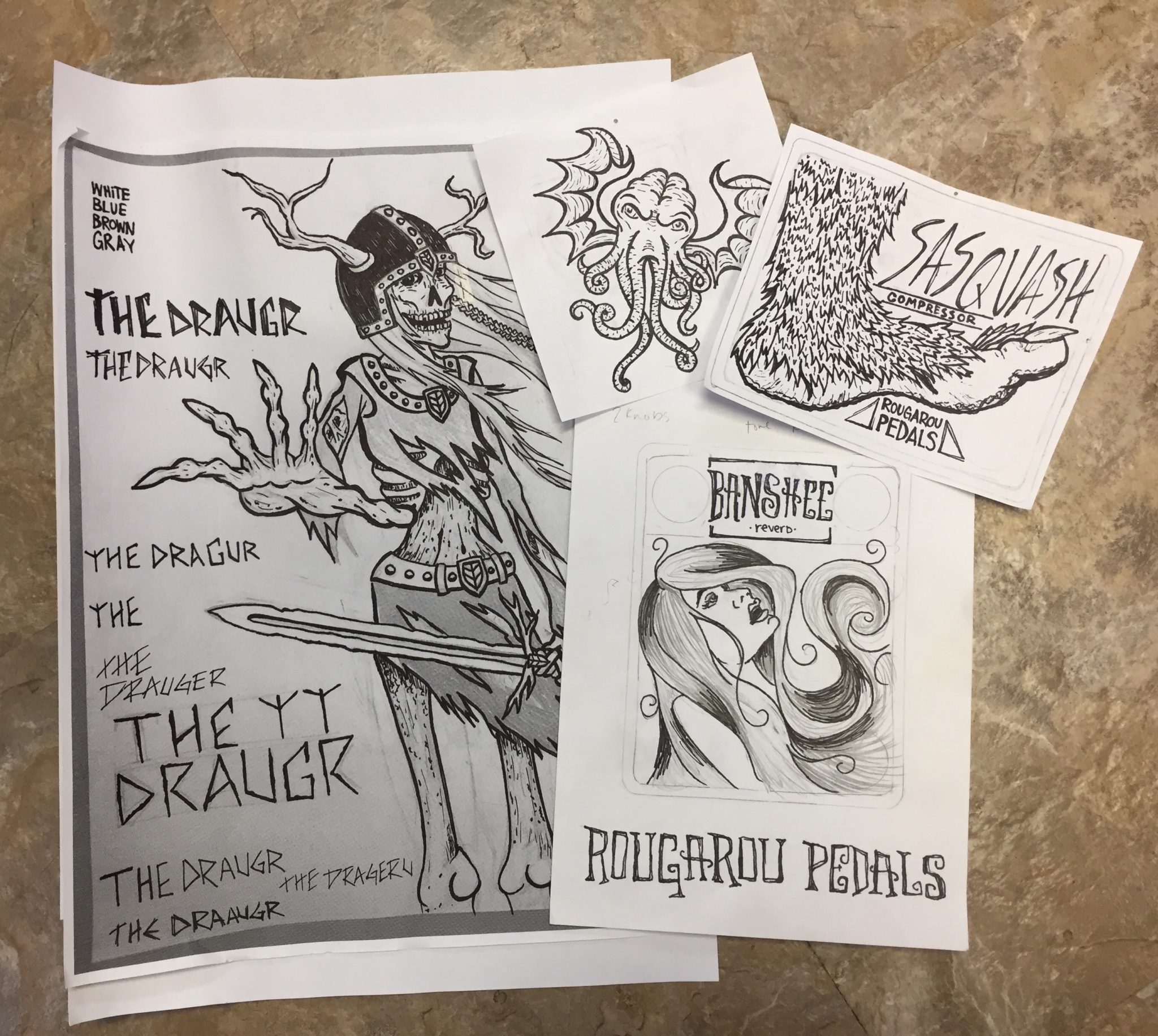Beware of Banshees, Sasquatches and Draugr-naughts: This month we’re turning our attention towards America’s Bayou State with Hammond, Louisiana native Nathan Heck of Rougarou Pedals! Read on to learn about Heck’s transition from the world of harmonica gear and into the realm of guitar effects pedal design.
[Mimmo]: How would you tell the story of Rougarou Pedals?
[Rougarou]: The story of Rougarou Pedals is a long one. During my senior year of high school I began working for Lone Wolf Blues Co., which produces harmonica effect pedals (this has since expanded to include amplifiers, power supplies, microphones, etc.). They were kind enough to work around my university schedule when I began my studies there, and, after I graduated, I transitioned to being the general manager. Sometime in 2015, a coworker and I got the idea to build bass specific pedals. We released the Rougarou Bass Tube Overdrive (acting as a subsidiary of Lone Wolf Blues Co.), but the project kind of fizzled out. Towards the end of 2016, my wife, Kara, and I were looking an outlet to help us cope with a personal tragedy. We took over operations, revived the brand, expanded the line and ended up where we are today.

[Mimmo]: I’ve read up a bit and I did notice Rougarou is a husband & wife operation. How does that dynamic play out?
[Rougarou]: At its most basic level, Kara (a professional graphic designer) handles all of our artwork, branding, and social media; I design the circuits. We both build the pedals, and, while my design process is largely independent, I definitely bounce sound ideas off of her all the time. She’s an avid fan of guitar driven music, and I trust her ear more than my own sometimes. People always assume there’s some sort of tension when a husband and wife work together, but it’s more like hanging out with my best friend. We listen to music and conspiracy theory podcasts (mockingly) while building pedals; it’s a good time. I’d also like to add that we have another friend, Ryan Church, that helps us by building pedals and play-testing all of our pedals.
[Mimmo]: Give us a brief overview of Rougarou Pedals’ product line.
[Rougarou]: We currently have five pedals out, but I’ll quickly run through four of them here since The Draugr gets its own question.
The Rougarou Bass Tube Overdrive is a low gain overdrive that was designed to mimic the front end overdrive of mid-power bass heads like the Portaflex. Like all of our pedals, it’s very simply laid out with just a Bite (drive) and Volume control. Overdrive is achieved by way of sub-miniature triode tube. For guitar, it works well as “thickener” at the end of a drive chain.
The Boosthulhu is a crystal clear boost that puts just a hair of brightness on top. I’m always amazed at the variety of tones people can achieve with it based on guitar/pedal/amp pairings. So far, this is our most popular pedal. I suspect the awesome Cthulhu artwork has something to do with it.
I have used clean boost pedals for several years and never found exactly what I was hoping for until I tried the Boostlhulhu. It gives me exactly the tonal enhancement I had been looking for forever. Most boost pedals add an artificial hi and low end that I don’t care for but the Boostlhulhu adds very slight, smooth mid-range that truly makes my sound full and beautiful whether clean or with a distortion pedal. It immediately became an essential part of my sound.
– Duke Robillard (The Duke Robillard Band, Roomful of Blues, The Fabulous Thunderbirds, Bob Dylan, Tom Waits, etc.)
The Banshee Reverb is a simple, two knob spring-esque reverb. It uses the Belton reverb module that I’m sure a lot of DIY guys are familiar with. [Belton has since evolved into a merger with Accutronics, forming Accu-Bell Sound Inc.] It has a Blend control to adjust the level of reverb and a Tone control to go from dark to bright. There’s a bit of modulation when get the blend cranked. That’s my favorite part.
The Sasquash is (you guessed it!) a simple, two knob compressor. I, personally, don’t like a ton of options in a compressor because I think it makes achieving a “bad” sound way too easy. The compression stays in a reasonable range all the way up to max. This has been our second most popular pedal.
[Mimmo]: Congrats on your recent release of The Draugr Distortion! Give us a brief overview on The Draugr.
[Rougarou]: Thanks! We’re super excited about this one; she’s my baby. The Draugr is a germanium diode-based distortion that can cover a lot of ground in that grey area between overdrive and fuzz. For bass, I’ve found I like to leave it on a lower setting nearly all the time. On guitar, it does a lot of the classic big amp sounds. The Tone control is super interactive with the Drive control, and it makes this deceptively simple pedal extremely versatile. The most frequent comment we’ve gotten about it so far is that it stays super clear all the way through the drive control. If that’s your thing, you’ll probably dig it.
[Mimmo]: When you start thinking of building a new product where do you start? What is your design process like?
[Rougarou]: The ideas for new products are usually selfish in nature. With the Draugr, for example, I really wanted a distortion that played well with my board and Rickenbacker. With the idea in my head, I hand draw a schematic with the simplest possible circuit to achieve what I want to do. After that, I’ll breadboard it, see how close my brain’s understanding was to my ear’s expectations and make adjustments and additions (like clipping diodes in the Draugr; I probably tested 30 or so in the circuit.) I’ll usually build a prototype after that and gig with it for a bit to see what I like and don’t like in practical applications. Usually, that’ll result in another breadboarding phase, more fine tuning and play-testing on gigs; wash rinse, repeat. It’s a long process, but I think the results are worth it.
[Mimmo]: Are there any particular sounds you wish to capture but haven’t quite hit?
[Rougarou]: I have a very dark, bass heavy fuzz sound that is still present in the mix in my head. I stumbled across the basic idea while testing out different ideas in The Draugr development process, but I was scared of getting sidetracked in the middle of a project. I haven’t even started working on it yet, but it’s been bugging for a couple of months now. I probably should figure that out.

[Mimmo]: Are there any other pedal builders for which you have a definitive amount of respect? Any builders that you simply cannot get enough of?
[Rougarou]: I feel like I’m in a kind of weird situation here. I’ve been building pedals for myself since I was just a wee young lad, so I really don’t own too many pedals by other builders. I have a few mass market things I picked up a decade ago, a Fuzzrocious Grey Stache and a Mantic ATDI-limited run reverb, but that’s about it. I also was immersed exclusively in the harmonica gear culture for a long time, so the scene is still pretty new to me. I definitely respect the Fuzzrocious duo, though. Not going to lie, we look up to them for what a successful husband and wife team can do, and I really like that they push limits. Ryan has two of Mr. Black’s reverbs, and they’re incredible. Retroactive Pedals out of New Orleans (we love locals!) has a pedal called the Designated Driver, which sounds absolutely fantastic to me in all of the clips I’ve seen, and he’s a very knowledgeable guy.
[Mimmo]: Choose a genre and build a pedalboard for a guitarist in your chosen genre. Which Rougarou pedals would you select? Which products would you select outside of Rougarou?
[Rougarou]: Hmm, I’ll go for doomy, riffy psych a la Super Snake, and I’ll limit this to six pedals.
From us, I’d have the Draugr for the big, amp-like sounds, the Banshee as a nearly always on reverb and the Boostlhulhu to punch through for solos. From other companies, I’d pick the Mr. Black Eterna because I’m in love with the octave thing it does and everyone needs at least two reverbs, the Black Arts Toneworks Pharaoh because it’s the best sounding muff I’ve ever heard and an EHX Deluxe Memory Boy because it covers so many bases as far as delay is concerned.
[Mimmo]: Popular advice for learning how to design and build effects units usually bounces between purchasing kits and performing mods on existing pedals. Is this how you started? What advice might you have for “young players”?
[Rougarou]: I learned on the job from my friend and mentor, Randy Landry. Looking back, it’s incredible how lucky I was to stumble into that situation, and I think more builders should take young techs under their wing. For anyone starting out, I recommend reading as much information as you possibly can, but also take the time to verify what you read. There’s so much misinformation out there, and there can be a substantial disconnect from theoretical certainties and practical applications. Besides that, find someone who knows more than you and learn absolutely everything you can from them.
[Mimmo]: Where can we find/contact Rougarou Pedals?
[Rougarou]: You can find us at rougaroupedals.com, on Facebook, and on Instagram @rougaroupedals. Kara is most active on Instagram, and she always has some fun stuff up there. You can find our pedals in Boogieland Music in Hammond, LA (our hometown!), Guitar Center in New Orleans, Guitar Center in Baton Rouge and Guitar Pedal Shoppe in Plymouth, MA.
Thanks so much for talking with me! It’s been a blast.
